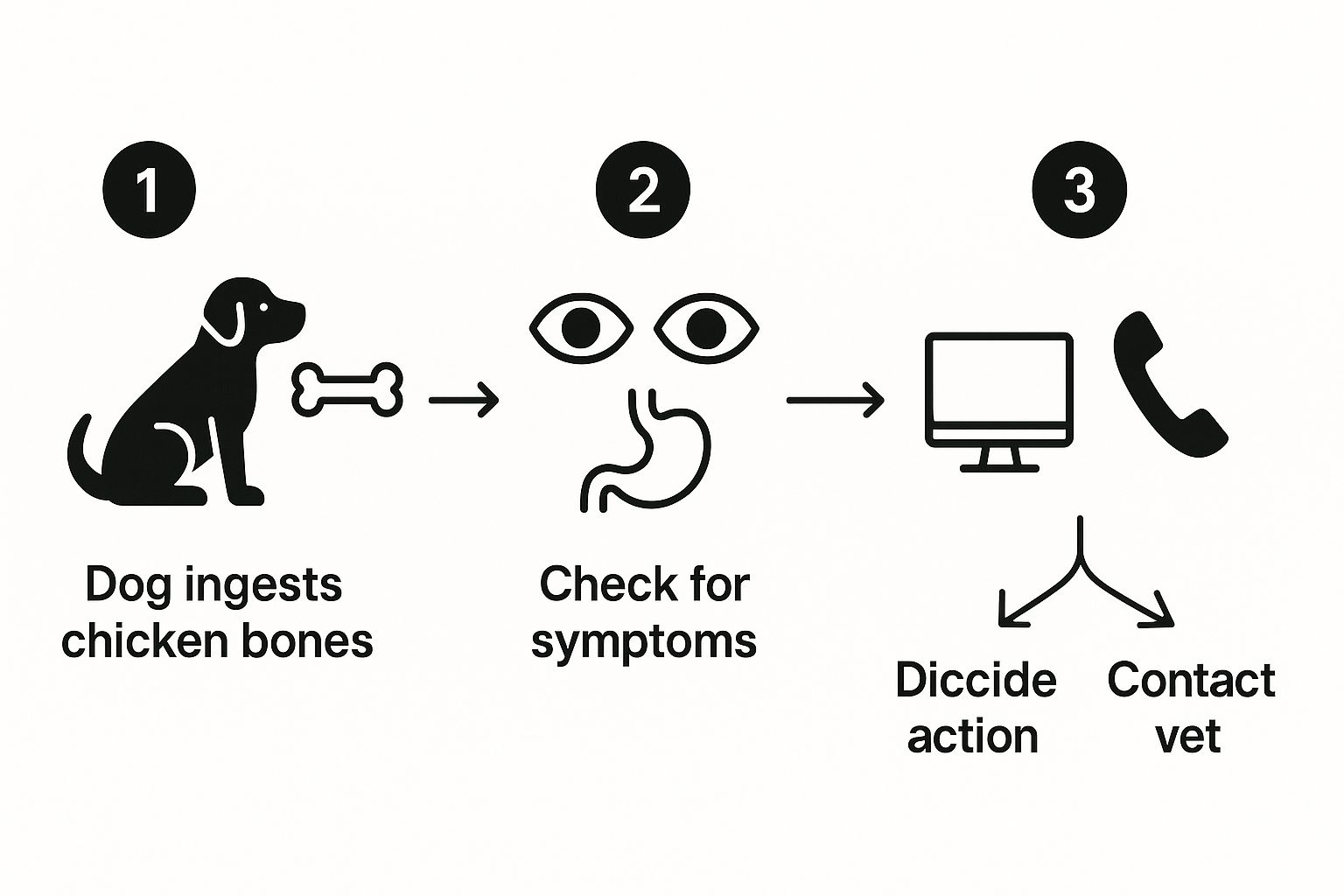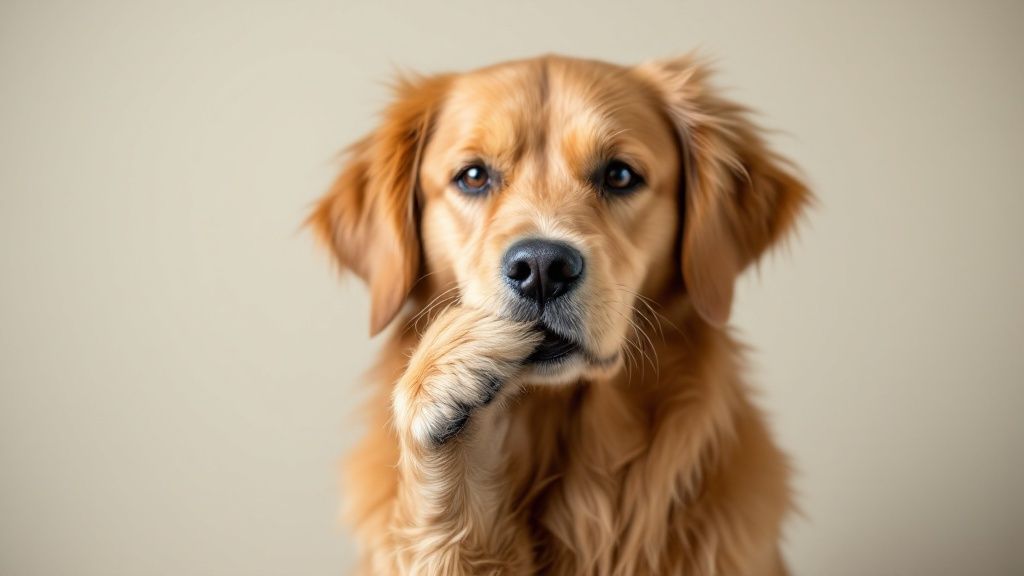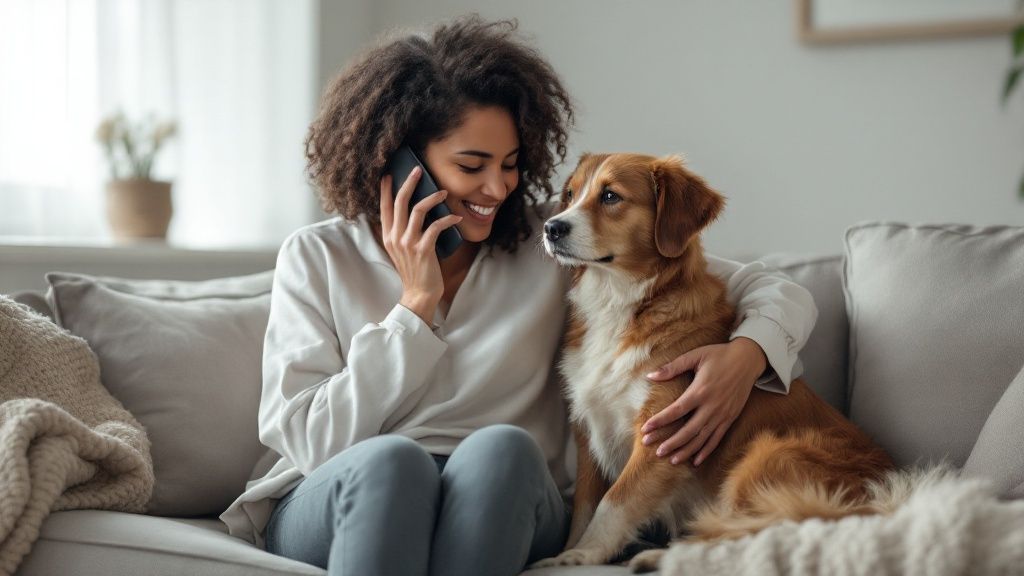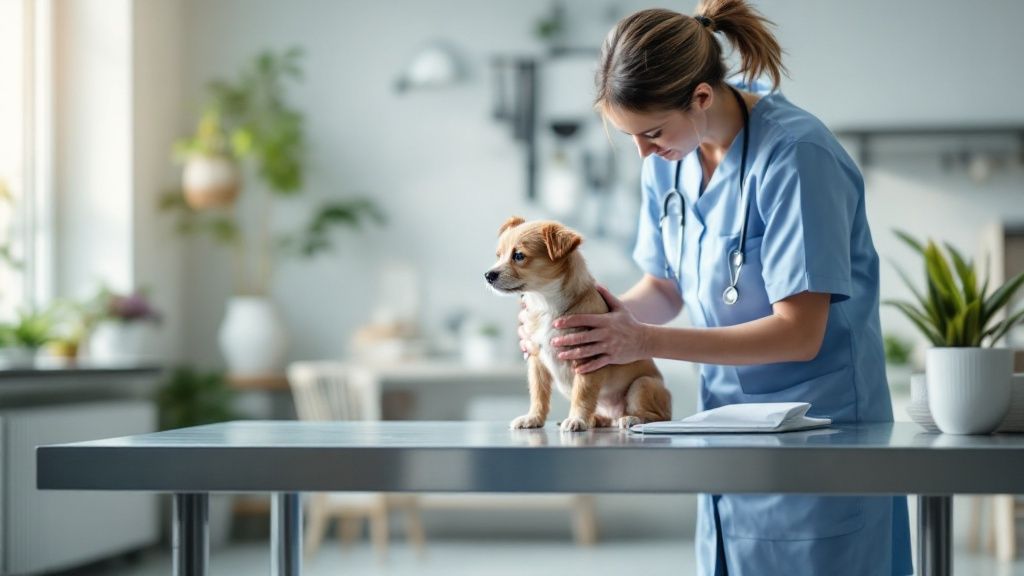It’s a heart-stopping moment every dog owner dreads. You look away for just a second, and that plate of leftover chicken bones is suddenly, terrifyingly empty. If your dog just ate chicken bones, the first and most important thing we need to do together is stay calm. Please do not try to make your dog vomit – this can do far more harm than good. What you and I do in the next few minutes is absolutely critical.
What to Do in the First 15 Minutes
That sudden spike of panic is completely understandable. I've been there, and it's a terrifying scenario. But panicking won't help you or your furry best friend. Let's walk through the immediate, calm steps you need to take right now to get a handle on the situation and keep your dog safe.
Your first job is to prevent any more bones from being eaten. Gently and safely get any remaining bones away from your dog. If they're still chewing, you might be able to carefully open their mouth and remove any large pieces still inside. Just be cautious; we know even the sweetest dog can snap when they're scared or protective over a high-value "treat."
Assess the Situation Calmly
Once you’ve secured the scene, take a deep breath and just watch your dog for a moment. Are they showing any immediate signs of distress?
Keep a close eye out for:
- Choking or gagging: This includes pawing at their mouth, coughing repeatedly, or visibly struggling for air. These are emergency signs.
- Excessive drooling: A sudden flood of drool can mean a piece of bone is stuck somewhere in their throat or oesophagus.
- Pacing or anxiety: If your dog seems restless or just can't get comfortable, it could be a sign of pain.
This quick assessment gives us vital information for what to do next. Knowing exactly how your dog is acting is key to getting them the right care. For a wider look at handling unexpected pet problems, our guide on dog first aid offers essential tips for common emergencies.
This visual guide quickly breaks down the process we'll follow.
As you can see, our next step is either to monitor your dog closely at home or to get straight on the phone with your vet, depending on the symptoms you're seeing.
To make things even clearer, here’s a quick checklist of what to do and, just as importantly, what not to do in the first few moments.
Immediate Action Checklist
| Do This | Why It's Important |
|---|---|
| Remove Remaining Bones | Prevents your dog from eating any more and making the situation worse. |
| Observe for Distress | Signs like choking or gagging require immediate veterinary attention. |
| Call Your Vet | Your vet can provide specific advice based on your dog's size and the situation. |
| Stay Calm | Your dog will pick up on your anxiety, which can increase their stress and discomfort. |
Following these simple 'dos' will put us in the best position to help your dog through this.
Why You Should Never Induce Vomiting
It might seem like the most logical thing to do, but forcing your dog to vomit after they've eaten cooked bones is incredibly dangerous. Cooked chicken bones are brittle and splinter into sharp, jagged fragments. If you make your dog sick, these shards can easily tear the oesophagus or throat on the way back up, or even become a serious choking hazard. It's a risk we just can't take.
Instead of trying any home remedies, let's focus on gathering information. How many bones do you think they ate? Were they cooked or raw? What's your dog's approximate weight? Having these details ready will help your vet give you the best possible advice when you call them – which should always be our next step.
Why Cooked Chicken Bones Are a Real Danger
You’ve probably heard it a thousand times: never, ever give a dog cooked chicken bones. It’s one of those bits of advice we all know, but it’s easy to wonder just why it’s such a cast-iron rule. The truth is, this isn't an old wives' tale; the danger is very real and rooted in simple science. Once we understand what cooking does to a bone, you'll see why we're taking this so seriously.
The cooking process, whether that’s roasting, frying, or boiling, completely changes the bone's internal structure. It sucks the moisture right out, leaving it incredibly brittle and weak. A raw bone has a bit of give, but a cooked one is like chalk—it shatters under the slightest pressure.
Instead of breaking into manageable chunks, it splinters into sharp, needle-like fragments. This is where the real danger lies. These tiny daggers can cause a world of trouble from the moment your dog starts to chew.
From Mouth to Stomach: A Treacherous Journey
The potential for harm starts immediately. Even before your dog swallows, those sharp edges can do significant damage. Imagine a splinter of bone lodging in their tongue, gums, or the roof of their mouth—it's incredibly painful and a perfect recipe for infection.
But the journey doesn't get any safer from there. As the bone fragments travel down the oesophagus, they can scrape or even puncture the delicate lining. This is where the risk escalates dramatically. A perforation, which is basically a tear or a hole, is a life-threatening emergency.
Once in the stomach, the situation becomes even more precarious. While a dog's stomach acid is powerful stuff, it might not dissolve large or numerous fragments fast enough to stop them from causing an obstruction or internal bleeding.
Vets see the real-world consequences of this every day. There was a case in Lincolnshire involving a three-year-old rescue dog named Molly who got hold of a cooked chicken carcass. The bone splintered and became lodged in her throat, causing extreme pain and needing emergency surgery. You can read more about Molly's emergency vet visit to understand just how serious it can be.
"The primary danger is perforation. A sharp bone fragment can poke a hole anywhere along the digestive tract, from the throat to the intestines. This allows digestive fluids and bacteria to leak into the abdomen, leading to a severe and often fatal infection called peritonitis."
The Myth of Raw vs Cooked Bones
So, you might be thinking, "What about raw bones? Are they okay?" While it's true that raw bones are less likely to splinter in that same dangerous way, they are not a safe alternative. They come with their own set of serious risks that we simply can't ignore.
- Choking Hazard: A dog can still easily choke on a raw bone if they try to swallow a piece that's too large for their throat.
- Dental Fractures: Hard raw bones are notorious for breaking dogs' teeth, leading to painful and very expensive dental work.
- Bacterial Contamination: Raw meat and bones are often teeming with nasty bacteria like Salmonella and E. coli, which can make both your dog and your family incredibly ill.
At the end of the day, the consensus among veterinary professionals is clear: no bones are truly safe for our dogs. The potential for a catastrophic emergency just isn't worth the brief moment of enjoyment. Understanding these dangers arms you with the knowledge of why a "wait and see" approach can be so risky when your dog ate chicken bones.
How to Monitor Your Dog for Warning Signs
Okay, the initial panic is over, and your dog might be bouncing around as if nothing happened. It's completely natural to want to breathe a huge sigh of relief and move on, but the next 24 to 72 hours are absolutely critical. This is our observation window. You need to become your dog’s chief health detective, watching for any sign that those chicken bones are causing a problem.
Internal issues can be sneaky. They often start small and take a while to become obvious. Your dog can't pipe up and tell you about a sharp poke in their tummy or a growing ache, so it's down to us to spot the clues.
Key Gastrointestinal Red Flags
Your first port of call is to keep a very close eye on your dog's digestive system. Any changes here are usually the first hint that something isn't right.
Let's be on the lookout for these specific signs:
- Vomiting or Retching: A single sick-up might not be cause for alarm, but repeated vomiting is a definite worry. Pay close attention to unproductive retching, where your dog is trying to be sick but nothing is coming up – that's a major concern.
- Changes in Stool: Look for anything out of the ordinary, like diarrhoea, constipation, or obvious straining when trying to go to the toilet. The most serious sign is blood in their poo, which could look like bright red streaks or have a dark, tarry appearance.
- Loss of Appetite: If your dog, who normally inhales their food, suddenly turns their nose up at a meal, it’s a clear signal they're not feeling themselves.
These symptoms are textbook for a dog who's swallowed chicken bones. A UK-based veterinary study noted that among dogs who presented with bone obstructions in their stomachs, a massive 83% showed signs like vomiting, with others suffering from diarrhoea and anorexia. You can read the full veterinary research here if you want to dive deeper into the findings.
Observing Behavioural and Physical Changes
Beyond toilet habits, your dog’s general mood and behaviour will tell us a lot. Sometimes the biggest warning signs are the quietest ones.
Notice any of these shifts in their normal personality:
- Lethargy or Weakness: Is your dog less excited about their walk or a game of fetch? A sudden dip in energy or seeming unusually tired is a definite red flag.
- Abdominal Pain: This can be tricky to spot. Look for a hunched-over posture, a "praying" position (front end down, bum in the air), or if they seem sensitive when you gently touch their belly.
- Restlessness: If they're pacing, whining, or just can't seem to get comfortable and settle down, it could be a sign of pain.
A dog in pain will often try to hide it. You know your pet better than anyone else, so trust your instincts. If something just feels "off" about their behaviour, it’s always better to be safe and call the vet.
One physical check you can do at home is to take their temperature. A fever can be an early indicator that an infection is brewing inside. If you're not sure how to do this safely, you might find our guide on how to check your dog's temperature helpful.
By carefully watching these key areas, you're giving your dog the best chance of getting through this without any trouble. It’s a good idea to keep a little notebook to jot down any symptoms and the time they happened. This information will be incredibly useful if you end up needing to speak with your vet.
When You Need to Call the Vet Immediately
While it's wise to monitor your dog, some situations are well past the 'wait and see' stage. This is when we stop observing and start acting. If your dog has eaten chicken bones and is now showing any of the serious symptoms we're about to cover, it's a genuine, drop-everything emergency. You must call your vet or an emergency clinic right away.
I know how stressful this can be, but your quick action could make all the difference. Recognising these red flags removes the guesswork and gets your best mate the help they need when every minute counts.
Unmistakable Signs of an Emergency
Some symptoms are so clear and dangerous that they scream "crisis." If you spot any of the following, your dog needs urgent medical attention.
Here are the critical signs to look for:
- Active Choking or Difficulty Breathing: This is the most urgent scenario of all. Look for frantic pawing at the mouth, wheezing, coughing without actually clearing their throat, or any bluish tinge to their gums. A bone may be blocking their airway.
- Repeated, Unsuccessful Vomiting: If your dog is retching and heaving but nothing is coming up, it’s a classic sign of a blockage in their oesophagus or stomach.
- Excessive Drooling or Inability to Swallow: A sudden flood of drool, often combined with frantic gulping, can mean a bone fragment is painfully lodged in their throat.
These symptoms point to a physical obstruction that won't resolve on its own. It's a situation that requires immediate veterinary intervention to prevent a tragic outcome. If you are in the Sheffield area and find yourself in this situation, having the number for an emergency vet in Sheffield on hand is a real lifeline.
Preparing for the Vet Call
When you phone the vet, they will need some key details to give you the best advice. Being prepared helps them quickly assess just how serious the risk is.
Before you dial, take a deep breath and gather your thoughts. Your vet will probably ask for your dog's breed and approximate weight, how many bones you think they managed to eat, and a clear description of the symptoms you're seeing. This information is vital for their initial assessment.
Data from the UK charity PDSA really brings home how serious these situations can become. One report detailed the case of a dog named Sapphire who needed emergency surgery after a swallowed chicken bone lodged in her stomach, creating a life-threatening blockage. Vets always stress that cooked bones can splinter into sharp shards, causing horrific internal damage.
If your vet prescribes medication after an emergency, it might be helpful to learn how to use an online vet pharmacy to manage their prescriptions more easily. At the end of the day, trusting your gut is crucial; if you feel something is seriously wrong, it probably is. Don't ever hesitate to make that call.
Preventing the Next Bone-Related Accident
Phew. The crisis is over, you’ve watched your dog like a hawk, and it seems like you’re in the clear. That feeling of relief is just immense, isn't it? Now, let's switch gears from panic mode to prevention mode. The goal is to make sure you never have to go through that heart-in-your-throat experience again.
The brilliant news is that stopping a repeat performance is completely in your hands. It all boils down to creating a "dog-proof" environment, especially when it comes to tempting food scraps. Let's turn your home into a fortress against future bone raids.
Fortifying Your Kitchen
The kitchen is almost always ground zero for these near-disasters. Let’s be honest, a determined dog can be surprisingly clever when the smell of leftover chicken is wafting from the bin.
Your number one line of defence is a solid, dog-proof bin. Look for one with a heavy lid they can’t just nudge open or, even better, a locking mechanism. For the canine Einsteins out there, keeping the bin inside a pantry or a cupboard might be the only guaranteed solution. It also helps to get into the habit of taking the rubbish out straight after a meal involving bones.
It's a simple change, but it really works. By removing the temptation entirely, we eliminate the risk. Out of sight and out of smell truly is out of mind for most dogs.
Managing your dog during busy times is also key. Think about family meals or summer barbecues – this is when plates are left on low coffee tables and guests, bless them, just don't know the rules. It can be much safer (and less stressful for everyone) to pop your dog in another room with a safe chew toy until everything is cleared away.
Training and Safe Alternatives
Beyond changing the environment, we can also work on our dogs' behaviour. Good training is an incredibly powerful tool for prevention.
Teaching a rock-solid "leave it" command is one of the most valuable things your dog can ever learn. Seriously. It’s not just for chicken bones; it's for dropped pills, dodgy-looking things on a walk, and anything else they shouldn't be gobbling up. This single command can literally be a lifesaver.
Finally, we need to give them an outlet for that natural urge to chew. Dogs explore the world with their mouths, and chewing is a healthy, normal behaviour we should encourage—safely. Instead of risky cooked bones, let's give them some brilliant, enjoyable options.
Here are a few vet-approved alternatives to keep them happy:
- Durable Rubber Toys: Brands like Kong are fantastic. They make tough toys you can stuff with treats, giving your dog a good mental workout as well as a safe chew.
- Dental Chews: Look for chews that have been approved by veterinary dental health groups. They do a great job of helping to clean teeth while satisfying that need to gnaw.
- Edible Chews: Things like bully sticks or yak milk chews can be a great treat, but always keep an eye on your dog to make sure they aren't swallowing massive chunks.
By combining a secure home with consistent training and plenty of safe chew toys, you can relax, knowing your furry family member is protected from another dangerous misadventure.
Common Questions About Dogs and Chicken Bones
Once the initial panic subsides, it's natural for a hundred new questions to start racing through your mind. It's a stressful and confusing moment, and you just want to make sure you're doing everything right for your dog. We've pulled together some of the most frequent queries we hear from worried owners to give you a bit more clarity and peace of mind.
Of course, every dog and every situation is different. Your vet is always your best port of call, as they can give you advice tailored specifically to your furry friend.
Should I Give My Dog Bread to Cushion the Bones?
This is one of the most common bits of "wisdom" you'll find floating around the internet. The theory goes that something soft like bread will wrap itself around the sharp bits of bone, helping them travel through the gut more safely.
While it seems to make sense, many vets in the UK now advise against it. Giving your dog a load of extra food adds bulk to their stomach, which could make a potential blockage worse. It can also make it much harder for your vet to get a clear X-ray if they need one.
Before you reach for the bread bin, phone your vet first. They’ll tell you if it's a good idea based on your dog's size, what they ate, and how long ago it happened.
How Long Does It Take for a Chicken Bone to Pass?
This is the big question every owner has during that nail-biting waiting period. Unfortunately, there isn't one simple answer. The time it takes can vary wildly depending on your dog’s breed, size, metabolism, and the size of the bone fragments themselves.
Generally, you could be looking at anywhere from 12 hours up to a few days. The most critical window to watch them is the first 72 hours. This is when signs of a serious issue, like a tear or an obstruction, are most likely to show up. Don't make the mistake of thinking you're in the clear just because your dog seems fine after 24 hours.
Are Raw Chicken Bones Any Safer Than Cooked Ones?
You might be wondering if raw bones are a safer bet. It's true that raw bones are less brittle and less prone to splintering into those dangerously sharp shards. However, they are definitely not risk-free.
Here’s why you still need to be cautious:
- Choking and Blockages: A dog can just as easily choke on a raw bone or get an intestinal blockage if they swallow a chunk that's too big.
- Dental Damage: Hard raw bones are a frequent culprit behind painful and expensive cracked teeth in dogs.
- Bacterial Risk: Raw meat and bones can carry nasty bacteria like Salmonella or E. coli. This isn't just a threat to your dog, but to every human in your home, too.
Most UK veterinary associations agree that the safest bet is simply to avoid giving dogs bones altogether. There are countless safer, vet-approved chews on the market that provide all the dental benefits and fun without any of the danger.
At K9 Time, we know your dog’s safety and happiness are everything—because they’re everything to us, too. From first-aid advice to providing safe, stimulating walks, we're here to support you. Find out more about our dedicated one-on-one dog walking services in Sheffield at https://k9time.co.uk.





